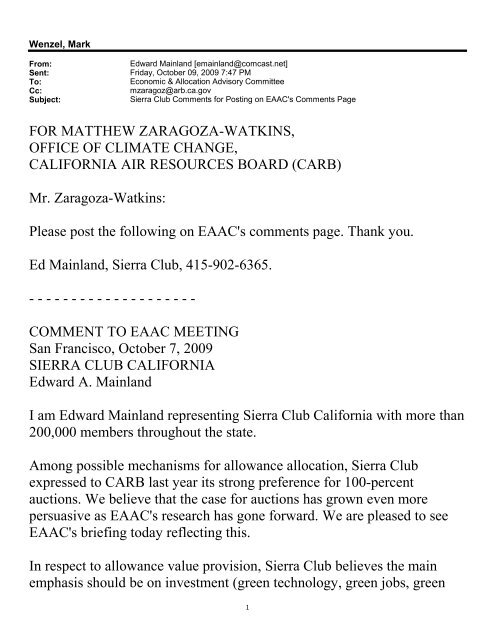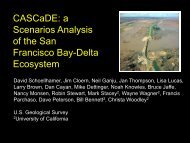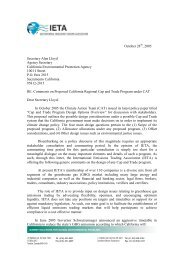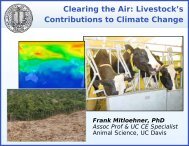Microsoft Office Outlook - Memo Style - California Climate Change ...
Microsoft Office Outlook - Memo Style - California Climate Change ...
Microsoft Office Outlook - Memo Style - California Climate Change ...
You also want an ePaper? Increase the reach of your titles
YUMPU automatically turns print PDFs into web optimized ePapers that Google loves.
Wenzel, Mark<br />
From:<br />
Sent:<br />
To:<br />
Cc:<br />
Subject:<br />
Edward Mainland [emainland@comcast.net]<br />
Friday, October 09, 2009 7:47 PM<br />
Economic & Allocation Advisory Committee<br />
mzaragoz@arb.ca.gov<br />
Sierra Club Comments for Posting on EAAC's Comments Page<br />
FOR MATTHEW ZARAGOZA-WATKINS,<br />
OFFICE OF CLIMATE CHANGE,<br />
CALIFORNIA AIR RESOURCES BOARD (CARB)<br />
Mr. Zaragoza-Watkins:<br />
Please post the following on EAAC's comments page. Thank you.<br />
Ed Mainland, Sierra Club, 415-902-6365.<br />
- - - - - - - - - - - - - - - - - - - -<br />
COMMENT TO EAAC MEETING<br />
San Francisco, October 7, 2009<br />
SIERRA CLUB CALIFORNIA<br />
Edward A. Mainland<br />
I am Edward Mainland representing Sierra Club <strong>California</strong> with more than<br />
200,000 members throughout the state.<br />
Among possible mechanisms for allowance allocation, Sierra Club<br />
expressed to CARB last year its strong preference for 100-percent<br />
auctions. We believe that the case for auctions has grown even more<br />
persuasive as EAAC's research has gone forward. We are pleased to see<br />
EAAC's briefing today reflecting this.<br />
In respect to allowance value provision, Sierra Club believes the main<br />
emphasis should be on investment (green technology, green jobs, green<br />
1
uilding, disadvantaged communities, Community Benefits Fund (AB<br />
1405)). Investment is the most direct and powerful use of carbon permit<br />
auction revenues to accelerate the transition to a low-carbon energy<br />
economy.<br />
Sierra Club is skeptical about Cap and Dividend -- returning cash<br />
payments to the public at large -- especially when this likely would leave<br />
inadequate funding for essential climate protection measures. Payouts for<br />
a indiscriminate "dividend" to induce support for added carbon costs<br />
would undermine the benefits of the program if the distribution were to<br />
compete directly with funds needed to protect the climate. Our<br />
calculations indicate that under any likely set of assumptions about fees,<br />
payout would be too small to be attractive to the public. Sierra Club would<br />
not oppose a dividend, however, if sufficient funds were first allocated to<br />
direct carbon reduction programs.<br />
Sierra Club proposes adoption of the following design principles for<br />
allocation of carbon-emission permit revenues:<br />
1. GHG Performance: Payments should be performance based, according<br />
to objective and independently verified measures of GHG reductions per<br />
dollar spent.<br />
2. Co-benefits: Prioritize measures that provide the optimal co-benefits of<br />
large GHG reductions combined with maximum feasible reductions in<br />
other pollutants that affect public health.<br />
3. Low Income Assistance: When any carbon assessment increases the<br />
cost of energy (e.g. gasoline, etc.), use revenues to offset these increased<br />
expenses to the most economically disadvantaged families and small<br />
businesses, particularly focusing on green jobs and economic development<br />
in low-income communities. Assistance with utility bills is already<br />
provided for low-income families. We recommend improved<br />
administration of the $1 billion in consumer assistance programs.<br />
2
4. Improve Equity: Prioritize measures that provide the largest feasible<br />
benefits for communities that are already subjected to environmental<br />
justice and cumulative impacts.<br />
5. Multiplier Benefits: Opportunities should be sought for using a<br />
multiplier effect, such as revolving loan funds, or matching funds.<br />
6. Upstream Leverage: Upstream intervention can lead to widespread<br />
changes and benefits, such as funding public planning for greenhouse gas<br />
reductions, assisting research and development, or inducing manufacturing<br />
and commercial development of green products that improve quality,<br />
reduce cost, or overcome supply bottlenecks.<br />
7. Accountability: measures should require communities and public<br />
agencies to agree to repay funds in proportion to shortfalls in meeting<br />
carbon reduction targets.<br />
8. Transparency: Performance metrics should be posted on the internet<br />
and provide avenues for public involvement in efforts to reduce<br />
greenhouse gases.<br />
9. Administrative Costs: Ensure adequate support for administering the<br />
carbon reduction programs.<br />
Insofar as EAAC may be seized with the issue of carbon offsets, Sierra<br />
Club recommends that EAAC draw from AB 1404, currently on the<br />
Governor's desk for signature. The bill contains what we believe are<br />
excellent policy directives for limiting, narrowing and controlling the use<br />
of offsets.<br />
In respect to EAAC's work on economic impacts, Sierra Club believes that<br />
a prime concern is retaining credibility. The public must be convinced of<br />
the reliability and plausibility of the research on which CARB's and<br />
3
EAAC's conclusions and recommendations may depend. Practitioners of<br />
the dismal science -- economists and econometricians -- these days rank<br />
below used-car salesmen for failing to foresee the housing bust,<br />
derivatives collapse, recession and regulatory failures. So Sierra Club<br />
urges EAAC to make sure that its economic analyses fairly account for all<br />
the benefits of GHG reductions and do not overestimate costs. Economic<br />
"impact" studies too often seem to the public like a myopic CPA looking<br />
at a business's books and seeing only the losses and not the profits. We'd<br />
like to see included estimates of externalities -- the benefits, direct and<br />
indirect -- of the transition to a low- or zero-carbon economy and the costs<br />
-- direct and indirect -- of inaction or half-measures. Health costs of<br />
continued carbon and other pollution and the benefits of CO2 reduction<br />
for co-pollutants, for example, are obvious candidates for inclusion on<br />
EAAC's balance sheets. Sierra Club agrees with other major<br />
environmental organizations that an EAAC public statement on economic<br />
modeling would be helpful for public debate to counter critics of the AB<br />
32 process.<br />
4







